
|   |

|   |
14th Guru Debaprasad Nritya Parampara and Award Festival - Manjari Sinha e-mail: manjari@sinha.com Photos courtesy: Debadhara Delhi December 16, 2021 Debadhara, the cultural organization of Guru Binayak Panda is known for propagating the unique Odissi dance style of Guru Debaprasad Das, which is an amalgam of the very essence of the tribal, folk and classical dance forms of Odisha. Guru Debaprasad Das was one of the pioneering gurus who worked for the recognition of Odissi dance as one of the Indian classical dance forms. Apart from organizing various events focused on Indian art and culture, Debadhara has also been honouring eminent artists with the 'Debadhara Lifetime Achievement Award' for their lifelong contribution in their respective fields. The 14th Guru Debaprasad Nrutya Parampara Award Festival was held in memory of the late Guru at the capital's Kamani auditorium on 4th and 5th December with music and dance performances featuring the awardees. 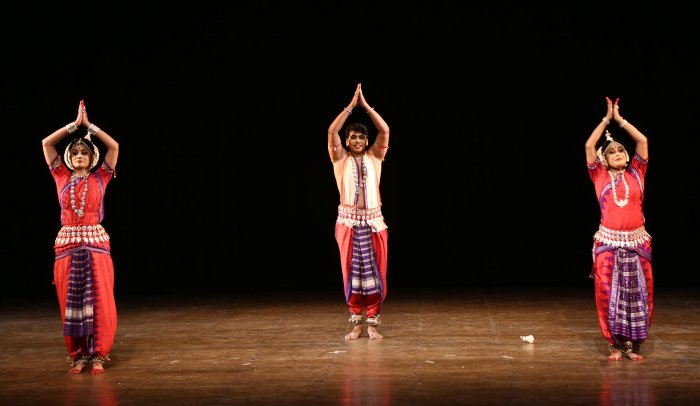 Disciples of Guru Gajendra Panda 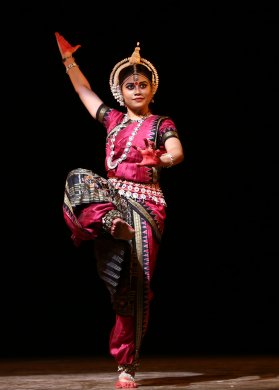 Ankita Kumari 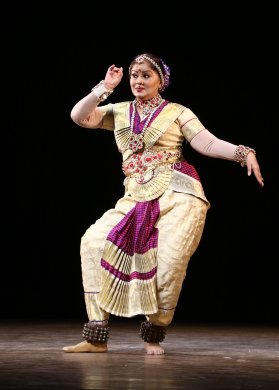 Sudha Chandran The two-day festival opened with the invocatory performance 'Gananayak Panchakam' by the Tridhara group of Guru Gajendra Panda, who had also choreographed the Odissi number. The five verses in praise of the auspicious deity Ganesha, the destroyer of obstacles, were composed in Ragamalika and Talamalika. The solo Odissi dance performance 'Durga' by Ankita Kumari, an A-Grade Doordarshan artist trained under Guru Binayak Panda, depicted Shakti, the female incarnation of the divine energy, as the Mahishasura Mardini. The remarkable piece composed in raga Patdeep, set to talas Triputa and Ektali was also choreographed by Guru Gajendra Panda. Sudha Chandran, the popular actress and Bharatanatyam dancer from Mumbai, presented 'Ramchandra' invoking Lord Rama, the Bhajan "Kaisi lagi lagan" comparing the devotion of Radha and Meera for their beloved Krishna and "Nache Mayuri" based on her own life story struggling against the challenges she encountered to become a Bharatanatyam dancer after losing a leg in an unfortunate accident. No wonder she was honoured with the Debadhara Samman. 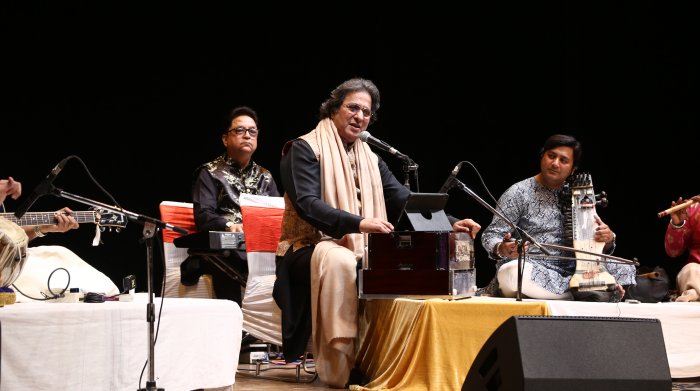 Talat Aziz The popular Ghazal singer Talat Aziz was the concluding artist of the inaugural evening. Initiated into music by Ustad Samad Khan and further trained under Ustad Faiyyaz Khan of Kirana Gharana, Talat is also groomed in Ghazal singing under Jagjit Singh and Mehdi Hassan. The audiences were looking forward to some semi-classical Thumri / Dadra or at least some classic Ghazals from the performing awardee, but surprisingly he presented just a couple of his popular film numbers like "Phir chhidi raat..." and "Zindagi jab bhi teri bazm mein laati hai hamen..." from the films like Umrao Jaan where the credit went to the creative genius of music composers like Khayyam. 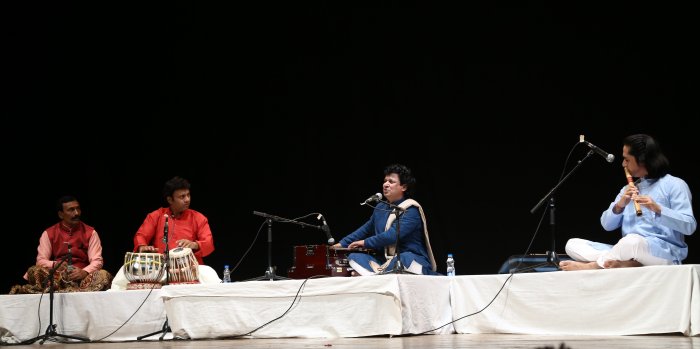 Guru Om Prakash The next evening opened with a number of appealing bhajans by Guru Om Prakash, whose open 'Aakar' at once reminded the music lovers of his revered Guru Pt. Bhimsen Joshi. The sonorous aalap in ragas that the bhajans were composed created the devotional aura for the lyrics by the saint poets. Raga Malkauns, for instance, for the Tulasidas Pada "Bhajman Ram charan sukhdayee..." or raga Bhimpalasi for "Bhaj le Hari ka naam" till the concluding "Jogi mat ja" composed in Bhairavi. The Bhairavi bhajan sounded very different from its immortal rendering by Late Pt. Omkar Nath Thakur, leaving everlasting impressions in one's memory. The Bhajaneek Theka on tabla, the melodious touches of the flute and the rhythmic support of manjira were simply perfect for the bhajans presented by the awardee. 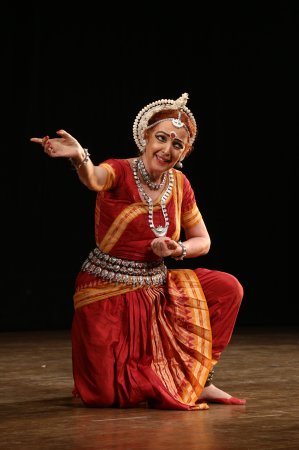 Ileana Citaristi The dance presentations this evening commenced with 'Ekalavya', the engrossing Odissi solo by dancer and author Ileana Citaristi. Based on the powerful Oriya version of the Mahabharata by Sarala Das, the piece dealt with the story of the tribal chief Jara who was not entitled to study at the martial school of the great Guru Dhronacharya due to his low caste origins. He practised in front of his Guru's mud statue and imbibed the skill and knowledge imparted by the master, watching the training from far away. With his dedication and rigorous practice, his expertise becomes a threat for all the other warriors, including Arjuna, the best pupil of the Guru. The master decides to test his devotion and Jara does not hesitate to sacrifice the thumb of his left hand and offers it to the Guru as dakshina. His Guru Bhakti (devotion to the Guru) remains proverbial for all generations to come and earned him the title of 'Ekalavya,' the 'incomparable'. The ekaharya abhinaya piece was choreographed by Guru Kelucharan Mohapatra for Ileana, his Italian disciple enacting different characters of the story with music by Prafulla Kar. Despite the lyrics in Odia language, Ileana could move the audience so deeply because she has been living in Odisha for a few decades in close proximity with the Odia people, their language and culture. Within the given time frame she presented a shorter version of the original choreography of her Guru but left the audience captivated with her layered emotive expressions, enacting all the characters convincingly. 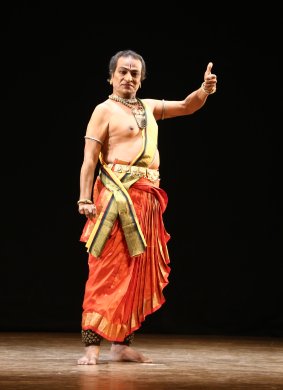 Guru Jayarama Rao Next came the enthralling Kuchipudi solo by Guru Jayarama Rao and a group presentation by his well-trained disciples. Opening with Venkatesh Stuti in raga Hindolam, Guru Jayarama Rao invoked the omnipresent Vishnu with a composition of Maharaja Swathi Thirunal in ragam Arabhi set to adi talam. He effectively incorporated the mythological story of Gajendra Moksham from Bhagavata Purana as an engrossing sanchari. The allegorical message through his powerful performance suggested that materialistic desires, ignorance and sins create an endless chain of karma in this world, similar to the crocodile preying upon the helpless elephant stuck in a muddy pond. 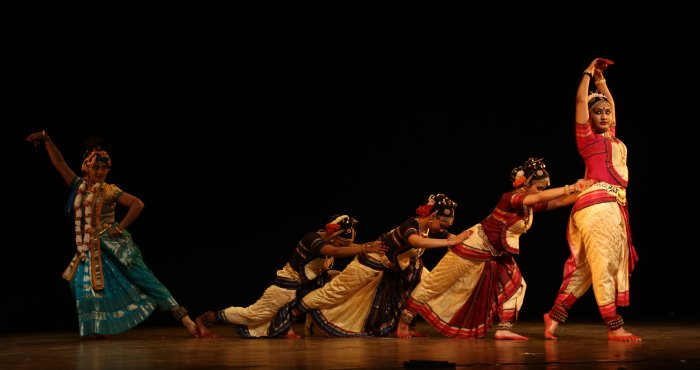 Guru Jayarama Rao's disciples The rhythmic group presentation by his disciples Sanjana Nair, Vidushi Balakrishnan, Sankita Das, Vaishnavi and T. Reddi Lakshmi was a scintillating Thillana composed by Ponnaiah Pillai in ragam Hamsanandi, adi talam. The choreography by Guru Jayarama Rao incorporated the 'Kaliya Daman' episode where the adolescent Krishna overpowered Kaliya by dancing on the multiple hoods of the multi-headed dreaded snake polluting the river Yamuna. The recorded musical score had vocals by Satish Venkatesh, mridangam and percussions by Tanjavur Kesavan, flute by Rajat Prasanna and violin by Raghavendra Prasad. 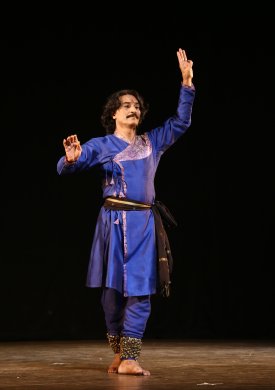 Pt Rajendra Gangani Pt Rajendra Gangani, the renowned Kathak Guru of Jaipur Gharana, was the concluding artiste of the festival. Ably assisted by the ace tabla player Fateh Singh Gangani, vocals by Samiullah Khan, pakhawaj by Yogesh Gangani and flute by Atul Shankar, Rajendra opened his impressive performance with Shiva Aradhana - "Bhasm bhushan angan Shiva, gale sohat munda maal", a Dhrupad in raga Jog set to Chautala. Surprisingly, the composition with the mudra 'Amar' was announced as composed by Pt. Amar Nath, whereas 'Amar' is the pseudonym of Ud. Aman Ali Khan of the Bhendi Bazar Gharana. With the melodious background of raga Yaman aalap on flute, Rajendra first of all paid obeisance to Guru Debaprasad Das and then proceeded towards his performance in teentaal with the lehera (the melodic refrain) continuing in Yaman itself. Opening with Upaj, the rhythmic footwork of umpteen varieties of impromptu improvisations he presented Uthaan, That, Amad, Parans and a long 'Kaliya-Daman'/'Naag-Nathan' Kavitta of Guru Narayan Prasad that went "Gend khelat, herat firat..", narrating the whole of the mythological story of Krishna's Kanduk Kreeda with Gwal-Bal on the shores of Yamuna, the ball falling in the river and his overpowering Kaliya Naag, the deadly snake, dancing on his numerous hoods, narrated as rhythmic poetry concluding with an emphatic Tihai. He also presented some rare Gat-Nikas of Jaipur Gharana, known for its Veer Rasa (valour), like the 'Talwar ki Gat' before presenting the abhinaya piece "Mala tilak manohar bana, laya sir chhatra dhare, Guru bin aisi kaun kare...", a bhajan eulogizing the greatness of the Guru. It was a long awaited live performance after a nearly two year long break of the Corona period, hence both the dancer and the accompanying artists were in high spirits inspired by the zestful give and take of a live audience. This came across with the concluding Sawal-Jawab, the impromptu repartee between the gunghroos of Rajendra Gangani and the tabla by Fateh Singh Gangani inviting thunderous applause. 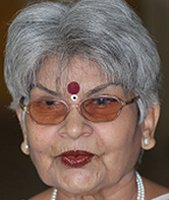 Manjari Sinha has an M.A. in Sanskrit and Music, and trained in vocal, tabla, sitar and Kathak dance. She has regular columns in national dailies as a music and dance critic. |